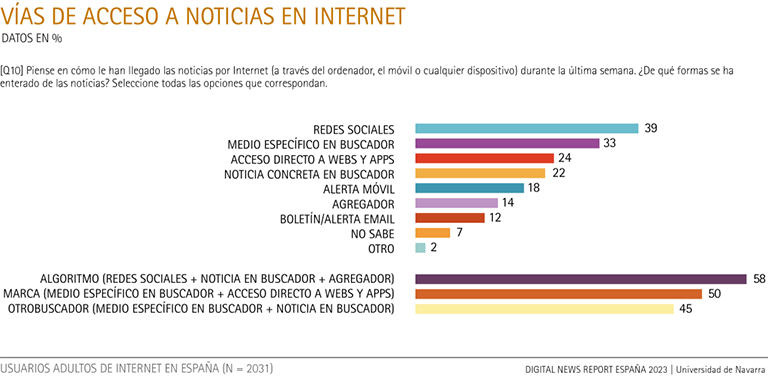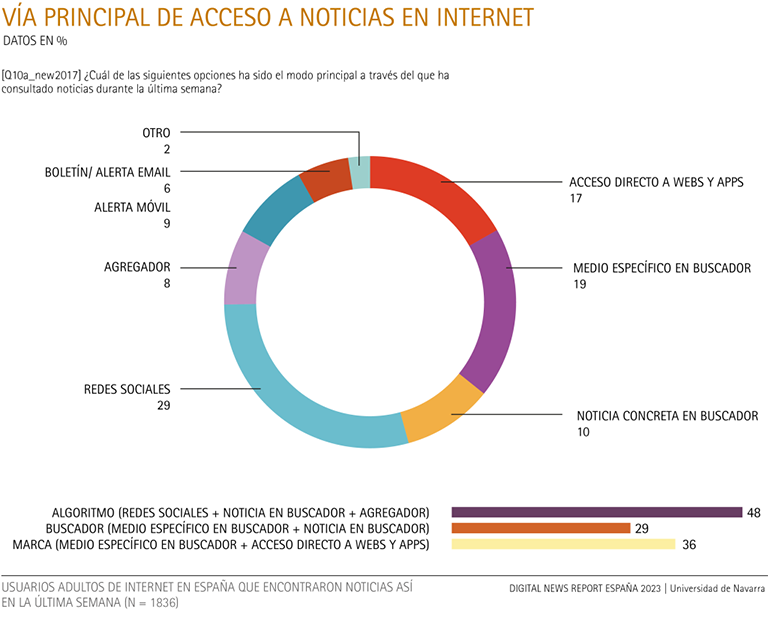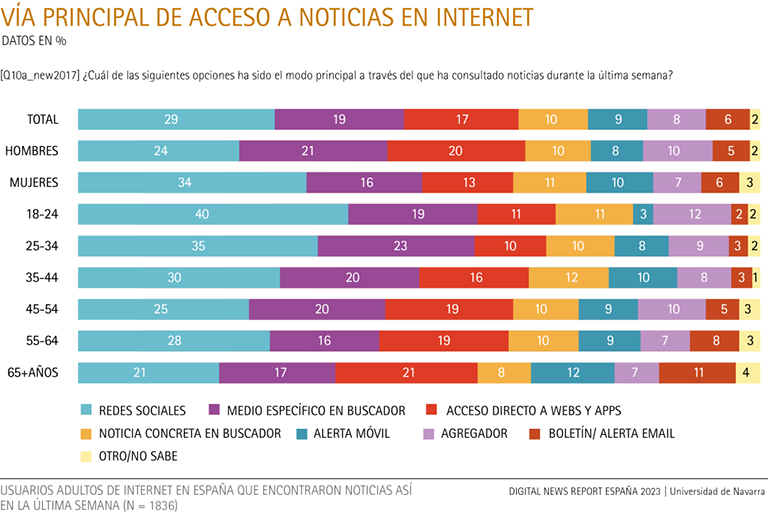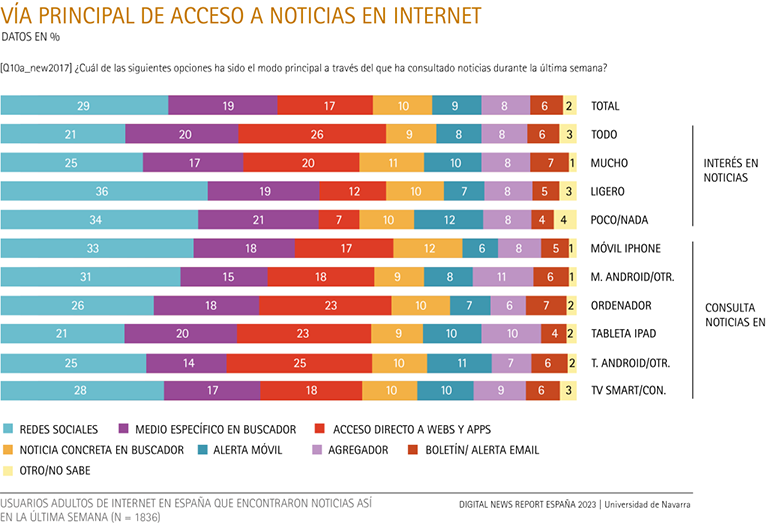-
39% of users access news via social networks in 2023, four points less than a year earlier, and 22% search for topics in search engines (-2 points).
-
Newsletters and e-mail alerts accounted for 12%, three percentage points less than the previous year.
Disintermediation in access to news continues, although the gap between algorithmic services (social networks, search engines by news topics and aggregators) offered by technology companies such as Alphabet or goal, which maintain their primacy despite falling from 62% to 58%, and the news media, which resist without losing any more ground, is narrowing.

Half of online adults (50%) regularly access news through media brands, either directly through their web address, through a bookmark they have saved in their browser or home screen, or their app, or by typing the name of the media outlet into a search engine such as Google. In fact, out of the total, one in three people (33%) type the name of the media outlet into a search engine, and one in four (24%, with some overlap) go directly to the media outlet's website or app, without going through Google or similar.
Against this behavior, in 2023, one in four users (39%) enquiry will regularly access news through social networks, a drop of four percentage points compared to the previous year. Together with searching for specific news in search engines (22%, down two points from the previous year) and using services and applications that aggregate different news sources (14%, down four points), they make up what is known as accessing news through algorithms.
Two modalities that may correspond to both specific media and services that combine various sources are mobile push alerts or notifications, which have remained at 18%, unchanged year-on-year, and email newsletters or alerts, which suffer the general decline: they are down to 12%, three points less in 2023 than the previous year.

We now focus on the priority choice of those who used some means of accessing news online in the last week in Spain. Forty-eight percent enter mainly through an algorithm (29% through social networks, 10% by entering queries by topic in search engines, and just over 8% who mainly use news aggregators), compared to 36% who do so through a brand: 17% direct access and 19% by entering the name of the medium in a search engine. In addition to all these modalities, 9% use push alerts (from media or other apps) and almost 6% use newsletters and email alerts.

The predilection of women for access through social networks stands out (34%), which surpasses the combination of both modalities of direct access to the media (30%), as is also the case among all adults up to 34 years of age.
Younger users are particularly averse to mobile alerts: only 3% use them as a priority, compared to 12% of those over 65. The use of email bulletins and alerts(newsletters) also multiplies in relation to age; specifically, it quadruples from just under 2% (18-24 years) or 3% (25-44 years) to 8% (55-64 years) or 11% (65 years and over). News aggregators have an almost opposite usage profile , with more popularity in the 18-24 age group (12%) and less so for those aged 55 and over (7%).

A lower level of income is associated with a greater choice of social networks to access news: in the low-income group , one in three opt for this route primarily to find news (33%), more than doubling direct access to websites and apps. In contrast, among high-income individuals, they prioritize direct access to news brands (21%) almost as many as those who seek information on social networks (23%) more than in any other way. Considering the level of programs of study, the differences in the itineraries of access to news are less important.
Being informed less frequently than daily, but more than once a week, significantly influences the choice of some ways of accessing news, such as social networks, whose use as a means of entrance to information increases among these less loyal audiences to 35%, or enquiry in news search engines on specific topics, with 15%, half more than the average, which is marked (10%) by the majority of Spanish adults, who are informed on a daily basis. In contrast, these more sporadic audiences have a much lower use of direct access to websites and apps (10%, just over half of the overall figure) and newsletters (2%, a third of the total).

Those who are most interested in the news access it in greater proportion through the news brands, to over 45%, of which more than half directly access the website or the media application (26%). On the other hand, those who have little or no interest in the information only opt for 7% to access the media directly (this is the modality in which there are the greatest differences according to interest), and an additional 21% put the names of the media in search engines (a behavior that cuts across all levels of interest), so that access through the brand remains at 28% among those less interested in the information.
The priority use of search engines to find information on specific news (one out of ten users) and the preference for aggregators (8%) are equally intense at all levels of interest in current affairs.
By internet-connected devices used to access the news, the highest access through social networks among Apple (33%) and Android (31%) smartphone users stands out above the average for this pathway. Likewise, the entrance direct access to websites and apps and media from Android (25%) and Apple (23%) tablets and computers (23%). Also, the use of aggregators among those who use an Android smartphone (11%) or an Apple iPad (10%).